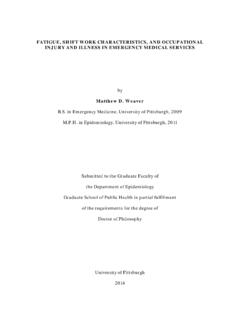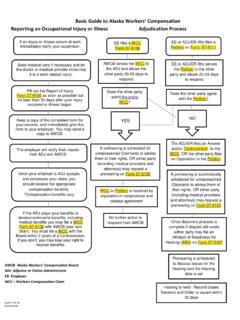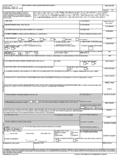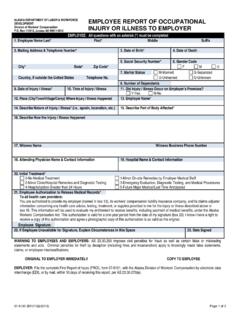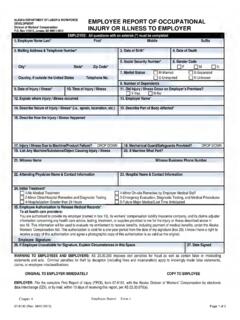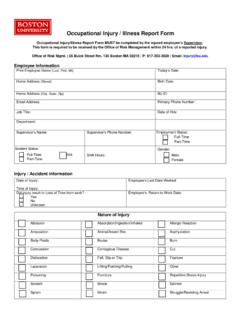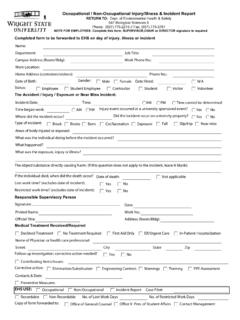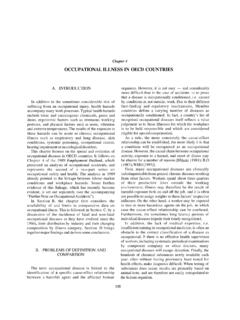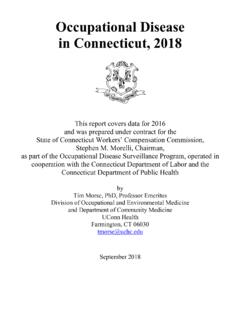Transcription of Statistics of occupational injuries
1 Andrina Laurie - 1 INTERNATIONAL LABOUR ORGANIZATIONICLS/16/1998/IIIR eport IIIS tatistics of occupational injuriesSixteenth International Conference of Labour StatisticiansGeneva, 6-15 October 1998 INTERNATIONAL LABOUR OFFICE GENEVAA ndrina Laurie - 22H:\WPWIN\WP6WE\MEETINGS\ICLS\ of the report3A framework for occupational and uses of Statistics of occupational and definitions8 occupational accident8 Commuting accidents9 occupational injury9 Case of occupational injury9 Incapacity for injuries11 Persons, economic activities and geographic of injury16 Fatal occupational injuries16 Time period and measures19 Frequency rates19 Incidence rates19 Severity rates20 Days lost per case of of of occupational work36 Bibliography37 Appendix. Draft resolution concerning Statistics of occupational injuries39 Annex A: Classification of economic activities45 Annex B: Classification according to size of establishment47 Annex C: Classification of occupations48 Annex D: Classification according to status in employment50 Annex E: Classification according to type of injury51 Annex F: Classification according to the part of body injured53 Annex G: Classification of place of occurrence5 Andrina Laurie - 3H:\WPWIN\WP6WE\MEETINGS\ICLS\ Laurie - 44H.
2 \WPWIN\WP6WE\MEETINGS\ICLS\ setting of standards for Statistics of occupational injuries dates back to 1923, when the First International Conference of Labour Statisticians (ICLS) adopted a resolution on Statistics of industrial accidents covering the classification of accidents and the calculation of frequency and severity rates. Subsequent studies of national practices and attempts made to ensure international comparability in the field of occupational injury Statistics revealed that the resolution adopted by the First ICLS needed revision, particularly in respect to the methods used to calculate injury rates. The subject was accordingly included in the agenda of the Sixth ICLS (1947), which adopted a resolution superseding the resolution of the First ICLS and making detailed recommendations on the methods to be followed in calculating frequency and severity the request of the Ninth ICLS, which noted in 1957 that the international recommendations in this field had been largely overtaken by events, the subject of industrial accidents was included in the agenda of the Tenth ICLS in 1962, which had before it a report based on the conclusions of a Committee of Experts convened by the ILO in 1959 and on information obtained from governments.
3 The Tenth ICLS adopted a resolution concerning Statistics of employment injuries , covering industrial accidents, commuting accidents and occupational diseases. With regard to the compilation of Statistics , especially of occupational injuries , the resolution set new international standards and defined for statistical purposes the notions of fatality, permanent disablement and temporary disablement. It suggested four classifications of accidents according to type of accident, the physical agency, the nature of the injury and the bodily location of the injury (ILO, 1976, pages 107-109). 20 years later, prompted by the lack of practical improvement in the comparability and availability of Statistics on occupational injuries , the 13th ICLS (1982) considered the topic again on the basis of the conclusions of a Meeting of Experts held in 1980 (ILO, 1982).
4 The resolution adopted by the 13th ICLS included new definitions of work accidents and occupational injuries and set out broad guidelines for coverage and classification. It also contained recommendations for the calculation of incidence and frequency rates (ILO, 1983, pages I/10-13). of occupational injuries are included in the provisions of the Labour Statistics Convention (No. 160) and Recommendation (No. 170), 1985. They are included in the list of basic topics on which countries are called upon to progressively expand their collection, compilation and publication of Statistics . Article 14(1) of the Convention establishes the coverage of Statistics of occupational injuries , while Paragraph 12 of the Recommendation gives guidance regarding periodicity of compilation and most frequent sources of these Statistics (administrative records of accident compensation schemes and of labour inspection services) evidently reflect the requirements of national labour legislation.
5 The 13th ICLS emphasized that, without changes to labour legislation and regulations, it would be difficult to make improvements in national Statistics and enhance their comparability between countries (ILO, 1983a). However, the new guidelines were not sufficient to encourage these changes and other sources of data were not envisaged. The situation therefore remained static regarding the Statistics , and even deteriorated in some on occupational injuries for some 113 countries, areas and territories were published in the 1997 edition of the Yearbook of Labour Statistics (ILO, 1997). A review of the national practices, for which information was collected by the Office in Andrina Laurie - 5H:\WPWIN\WP6WE\MEETINGS\ICLS\ with a view to the publication of the Sources and methods: Labour Statistics volume on occupational injuries (ILO, 1998c), reveals great differences between countries in both the coverage of the Statistics and the concepts and classifications used.
6 Where advances have been made, they have tended to take different directions so that the Statistics that are compiled are not easily comparable between countries, with the exception of the Nordic a result of the diversity of situations regarding the availability and comparability of information on occupational injuries and diseases in member States, the Governing Body convened a Meeting of Experts in October 1994 to draw up a code of practice on the recording and notification of occupational accidents and diseases. The Meeting adopted a code of practice based on a draft prepared by the Office, noting that "its provisions should be considered as the basic requirements for the collection, recording and notification of reliable data on occupational accidents and diseases, and related Statistics " (ILO, 1986, page VI). The code provides valuable guidance to the competent authorities on the development of systems for the recording and notification of occupational accidents and diseases, and for action by governments, social security institutions and other organizations aimed at the overall prevention of occupational accidents and diseases.
7 It gives more prominence to the effective use of recorded and notified data for preventive action than to the collection and compilation of recent decades, a number of countries have considerably developed their systems for the notification of occupational injuries and for the collection and compilation of Statistics in this field (see, for example, HSE, 1996; The Danish Labour Inspection Service, 1991; and United States Department of Labor, 1997). These developments concern not just the types of data collected and the coverage of the systems, but also the classifications used in order to improve the data available for prevention purposes. In addition, in January 1990, the European Union launched a study on European Statistics on Accidents at Work (ESAW), aimed at formulating proposals for the harmonization of Statistics of accidents at work throughout the European Union.
8 The project is managed jointly by the Statistical Office of the European Communities (EUROSTAT) and the Directorate-General for Employment, Industrial Relations and Social Affairs (DGV). Considerable progress has been achieved in this project in the development of common variables relating to occupational injuries and accidents, together with their respective classification systems, which are crucial to the goal of harmonization (EUROSTAT, 1992 and 1997). inadequacies of the current international guidelines on Statistics of occupational injuries can be summarized under two main categories: (a) the methods used for measuring occupational injuries , and (b) the classifications of occupational injuries . In recent years, many national authorities have turned to the ILO for guidance, particularly regarding classifications of occupational injuries .
9 As noted above, the ILO code of practice on the recording and notification of occupational accidents and diseases does not provide a great deal of guidance on the statistical measurement of occupational injuries . In addition, while still relevant to a certain extent, the classifications annexed to the resolution concerning Statistics of employment injuries , adopted by the Tenth ICLS in 1962, require updating to meet modern and future needs, as well as expansion, to cover growing demands for more analytical information about the causes of accidents and view of these developments, the Governing Body of the International Labour Office convened a Meeting of Experts on Labour Statistics in Geneva from 30 March to 3 April 1998. The Meeting was attended by 18 experts, six from each group nominated by the Governing Body. Nine observers and four representatives of intergovernmental organizations also attended the preparation for the Meeting, the Office drew up a report (ILO, 1998a) Andrina Laurie - 66H:\WPWIN\WP6WE\MEETINGS\ICLS\ with:(a)methods of measurement of occupational injuries ; and(b)classifications of occupational Meeting of Experts supported most of the proposals contained in the report, but expressed some reservations concerning some of the proposed classification schemes.
10 The Meeting s conclusions (ILO, 1998b) have been taken into account in the preparation of the present report, including the draft resolution on Statistics of occupational injuries presented in the appendix to this of the aims of this report are to discuss the major issues involved in the measurement and classification of occupational injuries and to make proposals for new international guidelines in this field. The Meeting of Experts recognized the need for revised standards on occupational injuries , but also emphasized the importance of Statistics on all areas of occupational safety and health, including occupational diseases, dangerous occurrences and the effects of stress, repetitive movements and other undesirable influences on the health of workers. These would not be covered by the guidelines under discussion, but the Meeting recommended that, once its developmental work for Statistics on occupational injuries had been completed, the ILO should develop standards for Statistics of occupational diseases, including upper limb disorders, repetitive traumas and similar relevant for statistical purposes, the provisions of the ILO code of practice on the recording and notification of occupational accidents and diseases have been taken as the starting-point for the draft recommendations contained in this report, as well as the terms of the ILO Labour Statistics Convention (No.)










